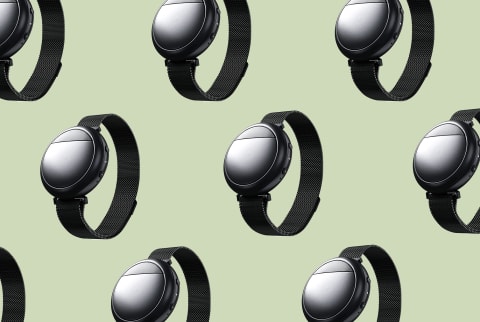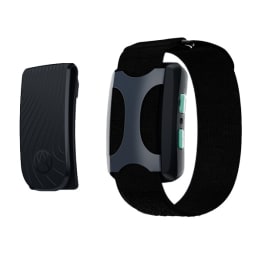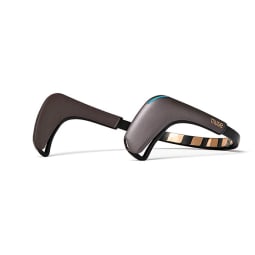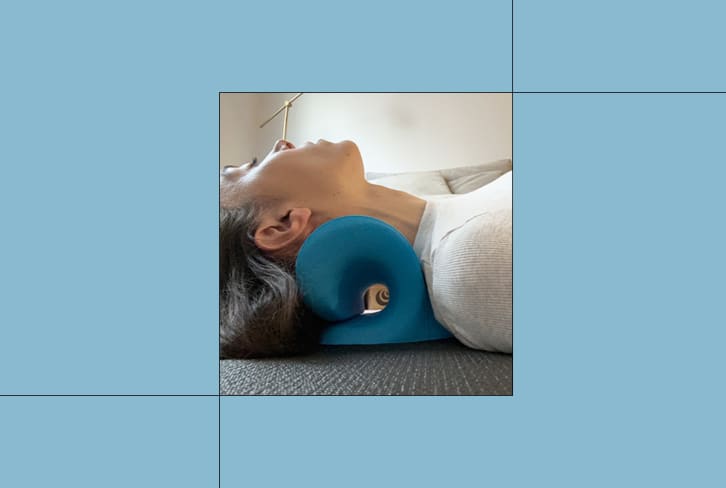Advertisement
The 5 Best Wearable Stress Relief Devices Of 2024 To Help Ease Your Body & Your Mind



Too much stress can wreak havoc on your body and mind, manifesting itself through many physical and mental symptoms, such as lack of sleep and increased anxiety. And while there's a lot you can do to manage day-to-day stressors, how do you know if your meditation practice, adaptogen smoothie, or journaling session is really making a difference? The best wearable stress relief devices provide clear, actionable data to track how your body is responding to everyday stressors, and use science-based techniques to lessen their impact.
While a great (and potentially life-changing) concept, opinions are mixed on whether these devices can actually help relieve stress. To learn more about the science behind stress and how these devices are meant to reduce it, we spoke with experts and researched the options available today. Below, find our picks for the best wearable stress relief devices—and hear what experts have to say about this technology.
The best wearable stress relief devices:
What is a wearable stress relief device?
Generally worn around the wrist, chest, or head, wearable stress relief devices vibrate at varying frequencies and pressures, meant to stimulate the skin and the nervous system. Some are designed to sense stress and respond automatically, while others operate when prompted. Many feature pre-programmed modes to assist with specific concerns such as general anxiety, focus, and social anxiety.
These vibrations are often made through low-frequency (20 to 200 hertz), or infrasonic sound waves (below 20 hertz), which are extremely quiet and often barely detectable by the human ear1. Some devices use binaural beats, or two almost equal tones at different frequencies, to stimulate a stress response. There has been limited research on this technique, but a 2017 study showed a binaural beat pattern to be an effective way to induce a meditative state2.
Another 2019 study that looked at the efficacy of High Amplitude Low Frequency-Music Impulse Stimulation (HALF-MIS) as an add-on treatment for depression had very positive results, finding the treatment to be more effective than standard depression treatment alone3. Many stress relief devices tap into this technique, using music and/or vibration to stimulate the vagus nerve and prompt a natural calming response in the body through the parasympathetic nervous system.
While brands and plenty of users say these wearables are a great stress-reducing alternative to medication and negative coping habits, the research isn't all there yet. Much information is lacking around the study methods and participants themselves—and few, if any, of these studies are peer-reviewed.
Do wearable stress relief devices work?
Unfortunately, science has yet to find the magic button that will zap all of our problems away forever. However, these wearable gadgets have been known to provide some relief, so long as you fill your end of the bargain and use them consistently. Like every stress management tool, they're only as effective as you make them. Regularly wearing these devices over time can help you learn to control your stress response and lower your cortisol levels so that you're better equipped to handle what life throws your way.
According to NYC neuropsychologist Sanam Hafeez, measuring stress isn't as simple as some of these devices make it out to be. "The nature of stress is complex," Hafeez says. "Although things like sweat and increased heart rate can be measured by technology, they don't always indicate anxiety. A cookie-cutter approach to stress relief is unlikely to work for all. For a stress relief device to be effective, it needs to collect data precisely, process that information, and accurately identify stress."
Still, especially when paired with more budget-friendly approaches to stress management (such as journaling, movement, and meditation), wearable stress relief devices can be a helpful addition to your self-care arsenal. And if they help you find even a few moments of calm in the midst of a hectic day, it could be well worth the investment.
How we picked:
Clinical studies
Because research is limited, we prioritized devices that have clinical studies to back their stress-reducing claims (or were in the process of conducting clinical studies).
Ease of use
The devices on our list have innovative features that are impactful yet easy to use.
Tracking capabilities
We looked for devices with apps that provide clear, actionable data to help users understand their stress levels and track improvements over time.
User feedback
Each of these devices has positive user reviews attesting to their stress-reducing efficacy. We used any negative feedback to inform our selection process.
Our picks for the best wearable stress relief devices:
Pros:
- Don't have to remember to use it
- Seven vibration modes
- Multiple options for wear
Cons:
- Takes up to 30 days to feel the full effects
How long it holds a charge:
6 to 8 hoursReturn policy:
30 daysResponsibility overload is a source of stress for many, so remembering to use your wearable stress relief device can feel like yet another task on your to-do list. The Apollo Neuro device makes taking care of yourself easy by seamlessly integrating into your everyday life.
Unlike other options, Apollo Neuro is designed to be worn all day long, providing you with silent yet soothing vibrations that are meant to retrain your nervous system so you can respond better to all of life's stressors. The Apollo Neuro sends silent, calming vibrations to the body, which are unobtrusive to your day, but relaxing for your body and mind. With the corresponding app, you can view your tracked metrics and choose one of the pre-programmed modes based on your goals, or make your own customized schedule for the device.
What’s more, this device can be worn in a multitude of ways (on your wrist, ankle, waistband, chest, or clipped to your shirt) by adults and children, and has the research to back its efficacy. The company’s co-founder, Dave Rabin, is a board-certified psychiatrist and neuroscientist who has studied stress for over 15 years. The brand has completed six clinical trials, with nine ongoing. According to the Apollo website, preliminary results suggest an impressive improvement in sleep, heart rate, and heart rate variability, after wearing the device for 3+ hours a day, 5+ days a week over the course of 3 months.
On Apollo's website, the device boasts 4.7 stars, with reviewers commenting on the discreet design and how it eases even some of the most intense forms of anxiety. One reviewer writes, "Ever since I got this product I have been able to drive again. Still have PTSD... But this helps control the episodes so I can function on the road."
Pros:
- Easy to use
- Immediate relaxation
Cons:
- No tracking features
How long it holds a charge:
1 week of daily sessions per chargeReturn policy:
40 daysWhat if 10 minutes to yourself each day was all it took to feel calmer and more present? While this isn't exactly a "wearable," the Sensate 2 is a small, stone-shaped device that you place on your chest, where it emits gentle vibrations that help you relax and check in for a 10-minute session every day.
The Sensate uses those previously mentioned infrasonic frequencies to stimulate your vagus nerve and signal your body to relax. These vibrations are paired with soundscapes that were specifically developed by the brand to help induce a state of calmness, safety, and relaxation.
To check in on how well the Sensate is working, the brand recommends measuring your heart rate variability. While the device does not measure this for you, there are plenty of great HRV trackers out there.
In 2022, the brand commissioned a study in adults who used the Sensate for an average of 3.5 months, 5 to 6 days per week. According to the brand’s website, over 70% of the participants scored in the low, mild, or normal stress classifications. Additionally, over 65% with anxiety disorder and over 50% with a depressive disorder noted an improvement in their condition when using the device.
There’s plenty of buzz around this brand and its wearable, with many positive reviews on the Sensate website (and no negative review at all…). On Amazon, the product has a 3.8-star rating out of 5. Reviewers are all about Sensate 2's portability and how quickly it can help you relax. One writes, "After a few moments of that, and a bit of worry about everything I had to do that day, it seemed that my brain turned off. Completely off."
Advertisement
Pros:
- Real-time feedback on your body's response to meditation
- Can track and measure progress
- Multiple soundscape options
Cons:
- Not for all-day use
How long it holds a charge:
5 hoursReturn policy:
30 daysMeditation can be the ultimate stress reliever, but many find it difficult to stay accountable to a regular practice, especially if you’re not feeling the results. Muse 2 is one of the few stress wearables designed to give you real-time feedback on how your brain, heart, body, and breath are all responding to your practice. Think of it like a fitness tracker, but for your mind.
According to the brand, neuroscience researchers around the world use this EEG device. The headband-style wearable has seven sensors that can detect when you're losing focus, which prompts soundscapes that gently guide you back to a calmer state. In the corresponding app, you’ll be given insights to help you stay calm and focused throughout the day. Your results are shown in a series of graphs and charts which show your brain, heart, and breathing activity. The app makes it easy to understand what’s going on in your mind, and how you might make adjustments to feel more relaxed and at ease.
The wireless device has a USB-port for charging and is adjustable to fit your head comfortably. Just note, there are no earbuds attached to the headband. Instead, you can pair it with your own headphones through bluetooth to play the meditations. The brand also offers a sleep tracking wearable, the Muse S, which tracks your sleep patterns to help you achieve a deeper, more restorative sleep.
The Muse 2 has a 4.2-star rating overall on Amazon, with many happy customers citing their improved meditation practice and sleep as a direct result of using the wearable. One reviewer writes, "The Muse does inspire me to meditate, and I can truly say that I feel the difference."
Pros:
- Great for hot sleepers
- Easy to use and wear
Cons:
- Not automatic—you have to push a button to activate it
- Only effective for menopause or while sleeping
How long it holds a charge:
not specifiedReturn policy:
30 daysThrough thermal sensations (both cooling and warming), this wearable triggers a relaxation response. It was originally designed to help menopausal women with hot flashes, but people who struggle to wind down at night have said it's been a game-changer for their sleep, helping their body cool down so they can fall asleep faster.
You can get on-demand relief through the push of a button on the device, or program it through the app, where there’s an option to set a specific temperature and duration (as short as 5 minutes or up to 9 hours). The app can also be used to track your usage and view any patterns.
A 2019 4-week randomized study looked at the effectiveness of this thermal treatment method in 39 women ages 45 to 58. Positive results suggested that this type of thermal intervention may provide sleep benefits, especially when it comes to falling asleep and staying asleep while experiencing hot flashes.
With over 1,000 reviews on the brand’s website, the device has a 4.2 rating overall. Most people say it works well and one writes, “I am truly amazed at how fast I cool off from a hot flash. Love this Embr wave and I can't imagine life without it again. Amazing product!” Others comment on the various modes and programs, describing the device as “worth every penny.” The only complaint seems to be around the battery life, which a few reviewers note could be better.
Advertisement
Pros:
- Clip-in design is easy and discreet
- More affordable
- Multiple speed settings
Cons:
- No tracking features
- Manual shut off
How long it holds a charge:
3 to 4 hoursReturn policy:
30 daysYou can’t put a price on stress relief, but if you're looking for a slightly more budget-friendly option, Touchpoint could be it. These small, clip-in devices attach to your clothing to deliver vibrations targeting specific pressure points on each side of your body—for fast, on-the-go stress relief.
Choose from three different speed settings: slow speeds for sleep or meditation, or faster speeds for managing anger and intense stress. Once prompted, the wearable will vibrate until you manually turn it off.
There are no reviews on the brand’s website, but the device has a 4.4 overall rating on Google, Reviewers sing their praises for Touchpoints' customer service and the gadget's simple yet effective design. Multiple people say the device makes a “huge difference” in managing anxiety and that they use it close to daily.
How do they stack up?
Apollo Neuro vs. Cove
Cove 1 was another big player in the wearable stress relief device game but has since discontinued its product and gone out of business.
Apollo Neuro vs. Touchpoint
Touchpoint is a slightly more affordable wearable stress relief device that uses vibrations to help you relax. However, it doesn't have any of the tracking features Apollo Neuro offers, and has far fewer vibration modes to choose from.
The takeaway.
Wearable stress relief devices are a convenient way to keep a pulse on what's going on inside your body and mind throughout the day. While they're not a one-and-done solution to the increasing demands of daily life, they can be an effective tool for tracking your body's response to specific stressors (so long as you use them consistently) and learning to shift your nervous system out of fight-or-flight mode. To dive deeper into the world of stress management, check out the best supplements for stress, how to use aromatherapy to relax, or the best meditation apps to keep you dedicated to your practice.
Meet The Experts
Watch Next
Enjoy some of our favorite clips from classes
Enjoy some of our favorite clips from classes
What Is Meditation?
Mindfulness/Spirituality | Light Watkins
Box Breathing
Mindfulness/Spirituality | Gwen Dittmar
What Breathwork Can Address
Mindfulness/Spirituality | Gwen Dittmar
The 8 Limbs of Yoga - What is Asana?
Yoga | Caley Alyssa
Two Standing Postures to Open Up Tight Hips
Yoga | Caley Alyssa
How Plants Can Optimize Athletic Performance
Nutrition | Rich Roll
What to Eat Before a Workout
Nutrition | Rich Roll
How Ayurveda Helps Us Navigate Modern Life
Nutrition | Sahara Rose
Messages About Love & Relationships
Love & Relationships | Esther Perel
Love Languages
Love & Relationships | Esther Perel
What Is Meditation?
Box Breathing
What Breathwork Can Address
The 8 Limbs of Yoga - What is Asana?
Two Standing Postures to Open Up Tight Hips
How Plants Can Optimize Athletic Performance
What to Eat Before a Workout
How Ayurveda Helps Us Navigate Modern Life
Messages About Love & Relationships
Love Languages
Advertisement

This Gave Me Osteoporosis At 32 & Here's What I Wish People Knew
AmiCietta Duche Clarke

New Study Shows This Vitamin May Lower Your Risk Of Alzheimer’s By 17%
Molly Knudsen, M.S., RDN

This Gave Me Osteoporosis At 32 & Here's What I Wish People Knew
AmiCietta Duche Clarke

New Study Shows This Vitamin May Lower Your Risk Of Alzheimer’s By 17%
Molly Knudsen, M.S., RDN


















